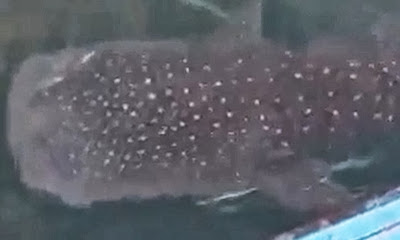Whale Shark
Whale Shark is the sole species in the family Rhincodontidae. It is found in the tropical and warm temperate seas around the globe. Whale shark is the largest fish in the world that can grow up to over 13 meters length. Despite its size, it is known to be harmless to human. It has a unique colour pattern of light spots and vertical and horizontal stripes.
It is often found on the water surface, sometimes in large schools. It mainly feeds on planktonic organisms, but will also takes on small fishes, crustaceans, and squids.
It is often found on the water surface, sometimes in large schools. It mainly feeds on planktonic organisms, but will also takes on small fishes, crustaceans, and squids.
Scientific Name: Rhincodon typus Smith, 1828
English Name: Whale Shark
Chinese Name | 鱼类中文名: 豆腐沙 (Dòu fu shā)
Malay Name | Nama Melayu Malaysia: Yu Paus
Thai Name | ชื่อสามัญภาษาไทย: ปลาฉลามวาฬ (Plā c̄hlām wāḷ)
Main Identification Features: Head very broad and flattened. Mouth very wide, almost terminal on head. Teeth very small and extremely numerous. Prominent ridges on dorsal surface and sides. Caudal peduncle depressed, with strong fleshy keels on side. Body with white or yellow spots and transverse stripes.
Size: Maximum total length 20 m, commonly to 12.1 m. Size at birth 55 to 64 cm. Males mature at 3 to 4 m and females mature after 7.6 m.
Habitat and Ecology: Coastal and oceanic waters, often at or near the surface, near shore or on the open sea, dive to 1,928 m depth, but usually to 100 m depth. Occurs singly or in schools. Pelagic filter feeder, feeds on small pelagic crustaceans, schooling fishes including anchovies, sardines, and even albacores, and squids. Migrate seasonally along coasts and concentrate in inshore tropical areas during part of the year.
Remarks: Endangered (2016 IUCN Red List).

English Name: Whale Shark
Chinese Name | 鱼类中文名: 豆腐沙 (Dòu fu shā)
Malay Name | Nama Melayu Malaysia: Yu Paus
Thai Name | ชื่อสามัญภาษาไทย: ปลาฉลามวาฬ (Plā c̄hlām wāḷ)
Main Identification Features: Head very broad and flattened. Mouth very wide, almost terminal on head. Teeth very small and extremely numerous. Prominent ridges on dorsal surface and sides. Caudal peduncle depressed, with strong fleshy keels on side. Body with white or yellow spots and transverse stripes.
Size: Maximum total length 20 m, commonly to 12.1 m. Size at birth 55 to 64 cm. Males mature at 3 to 4 m and females mature after 7.6 m.
Habitat and Ecology: Coastal and oceanic waters, often at or near the surface, near shore or on the open sea, dive to 1,928 m depth, but usually to 100 m depth. Occurs singly or in schools. Pelagic filter feeder, feeds on small pelagic crustaceans, schooling fishes including anchovies, sardines, and even albacores, and squids. Migrate seasonally along coasts and concentrate in inshore tropical areas during part of the year.
Remarks: Endangered (2016 IUCN Red List).
